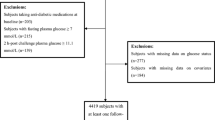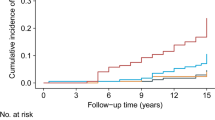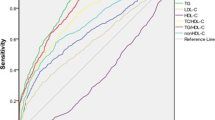Abstract
Aims
Previous study has reported that triglycerides-glucose (TyG) index, a product of triglycerides and fasting plasma glucose (FPG), might be useful in the prediction of incident type 2 diabetes (T2D). We evaluated the ability of the TyG index compared to FPG and OGTT as possible diabetes predictor in nondiabetic first-degree relatives (FDRs) of patients with T2D.
Methods
A total of 1,488 FDRs without diabetes of consecutive patients with T2D 30–70 years old (361 men and 1,127 women) were examined and followed for a mean (SD) of 6.9 (1.7) years for diabetes incidence. We examined the incidence of diabetes across quartiles of the TyG index and plotted a receiver operating characteristic (ROC) curve to assess discrimination. At baseline and through follow-up, participants underwent a standard 75-g two-hour oral glucose tolerance test.
Results
During 10,124 person-years of follow-up, 41 men and 154 women developed T2D. Those in the top quartile of TyG index were 3.4 times more likely to develop T2D than those in the bottom quartile (odds ratio 3.36; 95 % CI 1.83, 6.19). On ROC curve analysis, a higher area under the ROC was found for FPG (76.2; 95 % CI 71.9, 80.6), 1-hPG (81.0, 95 % CI 77.2, 84.9) and 2-hPG (76.5; 95 % CI 72.3, 80.8) than for TyG index (65.1; 95 % CI 60.5, 69.7).
Conclusions
TyG index is predicted T2D in high-risk individuals in Iran but FPG, 1-hPG and 2-hPG appeared to be more robust predictor of T2D in our study population.

Similar content being viewed by others
References
Whiting DR, Guariguata L, Weil C, Shaw J (2011) IDF diabetes atlas: global estimates of the prevalence of diabetes for 2011 and 2030. Diabetes Res Clin Pract 94:311–321
Guariguata L (2012) By the numbers: new estimates from the IDF diabetes atlas update for 2012. Diabetes Res Clin Pract 98:524–525
Shera S, Jawad F, Maqsood A (2007) Prevalence of diabetes in Pakistan. Diabetes Res Clin Pract 76:219–222
Satman I, Yilmaz T, Sengul A, Salman S, Salman F, Uygur S et al (2002) Population-based study of diabetes and risk characteristics in Turkey: results of the Turkish diabetes epidemiology study (TURDEP). Diabetes Care 25:1551–1556
Ashraf H, Rashidi A, Noshad S, Khalilzadeh O, Esteghamati A (2011) Epidemiology and risk factors of the cardiometabolic syndrome in the Middle East. Expert Rev Cardiovasc Ther 9:309–320
Chodick G, Heymann AD, Shalev V, Kookia E (2003) The epidemiology of diabetes in a large Israeli HMO. Eur J Epidemiol 18:1143–1146
Al-Mahroos F, McKeigue PM (1998) High prevalence of diabetes in Bahrainis. Associations with ethnicity and raised plasma cholesterol. Diabetes Care 21:936–942
Motlagh B, O’Donnell M, Yusuf S (2009) Prevalence of cardiovascular risk factors in the Middle East: a systematic review. Eur J Cardiovasc Prev Rehabil 16:268–280
Tuomilehto J, Lindstrom J, Eriksson JG, Valle TT, Hämäläinen H, Ilanne-Parikka P et al (2001) Prevention of type 2 diabetes mellitus by changes in lifestyle among subjects with impaired glucose tolerance. N Engl J Med 344:1343–1350
Knowler WC, Barrett-Connor E, Fowler SE, Hamman RF, Lachin JM, Walker EA et al (2002) Diabetes prevention program research group. Reduction in the incidence of type 2 diabetes with lifestyle intervention or metformin. N Engl J Med 346:393–403
Abbasi A, Peelen LM, Corpeleijn E, van der Schouw YT, Stolk RP, Spijkerman AM et al (2012) Prediction models for risk of developing type 2 diabetes: systematic literature search and independent external validation study. BMJ 345:e5900
Buijsse B, Simmons RK, Griffin SJ, Schulze MB (2011) Risk assessment tools for identifying individuals at risk of developing type 2 diabetes. Epidemiol Rev 33:46–62
Noble D, Mathur R, Dent T, Meads C, Greenhalgh T (2011) Risk models and scores for type 2 diabetes: systematic review. BMJ 343:d7163
Tirosh A, Shai I, Tekes-Manova D, Israeli E, Pereg D, Shochat T et al (2005) Normal fasting plasma glucose levels and type 2 diabetes in young men. N Engl J Med 353:1454–1462
Rhee SY, Woo JT (2011) The prediabetic period: review of clinical aspects. Diabetes Metab J 35:107–116
Janghorbani M, Amini M (2011) Normal fasting plasma glucose and risk of prediabetes and type 2 diabetes: the Isfahan Diabetes Prevention Study. Rev Diabet Stud 8:490
Simental-Mendía LE, Rodríguez-Morán M, Guerrero-Romero F (2008) The product of fasting glucose and triglycerides as surrogate for identifying insulin resistance in apparently healthy subjects. Metab Syndr Relat Disord 6:299–304
Guerrero-Romero F, Simental-Mendía LE, González-Ortiz M, Martínez-Abundis E, Ramos-Zavala MG, Hernandez Gonzalez SO et al (2010) The product of triglycerides and glucose, a simple measure of insulin sensitivity. Comparison with the euglycemic-hyperinsulinemic clamp. J Clin Endocrinol Metab 95:3347–3351
Abbasi F, Reaven GM (2011) Comparison of two methods using plasma triglyceride concentration as a surrogate estimate of insulin action in nondiabetic subjects: triglycerides × glucose versus triglyceride/high-density lipoprotein cholesterol. Metabolism 60:1673–1676
Warram JH, Martin BC, Krolewski AS, Soeldner JS, Kahn CR (1990) Slow glucose removal rate and hyperinsulinemia precede the development of type II diabetes in the offspring of diabetic parents. Ann Intern Med 113:909–915
DeFronzo RA (2009) From the triumvirate to the ominous octet: a new paradigm for the treatment of type 2 diabetes mellitus. Diabetes 58:773–795
Lee SH, Kwon HS, Park YM, Ha HS, Jeong SH, Yang HK et al (2014) Predicting the development of diabetes using the product of triglycerides and glucose: the Chungju Metabolic Disease Cohort (CMC) study. PLoS One 9(2):e90430
Amini M, Janghorbani M (2007) Diabetes and impaired glucose regulation in first degree relatives of patients with type 2 diabetes in Isfahan, Iran: prevalence and risk factors. Rev Diabet Stud 4(169):76
American Diabetes Association (2008) Executive summary: Standard of Medical Care in Diabetes-2008. Diabetes Care 31:S5–S11
World Medical Association (2009) Declaration of Helsinki, Ethical principles for medical research involving human subjects. J Indian Med Assoc 107:403–405
American Diabetes Association (2010) Diagnosis and classification of diabetes mellitus. Diabetes Care 33(Suppl 1):S62–S69
Friedewald WT, Levy RI, Fredrickson DS (1972) Estimation of the concentration of low-density lipoprotein cholesterol in plasma, without use of the preparative ultracentrifuge. Clin Chem 18:499–502
Expert Committee on the Diagnosis and Classification of Diabetes Mellitus (2003) Report of the expert committee on the diagnosis and classification of diabetes mellitus. Diabetes Care suppl 1:S5–S20
Alberti KG, Eckel RH, Grundy SM, Zimmet PZ, Cleeman JI, Donato KA et al (2009) Harmonizing the metabolic syndrome: a joint interim statement of the International Diabetes Federation Task Force on Epidemiology and Prevention; National Heart, Lung, and Blood Institute; American Heart Association; World Heart Federation; International Atherosclerosis Society; and International Association for the Study of Obesity. Circulation 120:1640–1645
DeLong ER, DeLong DM, Clarke-Pearson DL (1988) Comparing the areas under two or more correlated receiver operating characteristic curves: a nonparametric approach. Biometrics 44:837–845
Alyass A, Almgren P, Akerlund M, Dushoff J, Isomaa B, Nilsson P et al (2015) Modelling of OGTT curve identifies 1 h plasma glucose level as a strong predictor of incident type 2 diabetes: results from two prospective cohorts. Diabetologia 58:87–97
Gerstein HC, Santaguida P, Raina P, Morrison KM, Balion C, Hunt D et al (2007) Annual incidence and relative risk of diabetes in people with various categories of dysglycemia: a systematic overview and meta-analysis of prospective studies. Diabetes Res Clin Pract 78:305–312
Janghorbani M, Amini M (2009) Comparison of fasting glucose with post-load glucose values and glycated hemoglobin for prediction of type 2 diabetes: the Isfahan diabetes prevention study. Rev Diabet Stud 6:117–123
Janghorbani M, Amini M (2012) Incidence of type 2 diabetes by HbA1c and OGTT: the Isfahan Diabetes Prevention Study. Acta Diabetol 49(Suppl 1):S73–S79
Bastard JP, Lavoie ME, Messier V, Prud’homme D, Rabasa-Lhoret R (2012) Evaluation of two new surrogate indices including parameters not using insulin to assess insulin sensitivity/resistance in non-diabetic postmenopausal women: a MONET group study. Diabetes Metab 38:258–263
Vasques AC, Novaes FS, de Oliveira MDS, Souza JR, Yamanaka A, Pareja JC et al (2011) TyG index performs better than HOMA in a Brazilian population: a hyperglycemic clamp validated study. Diabetes Res Clin Pract 93:e98–e100
Acknowledgments
The authors are grateful to Mr. Majid Abyar for computer technical assistance. This study was supported partially by a grant from the Isfahan University of Medical Sciences, Iran. This research was performed as a part of the academic activity of the university.
Conflict of interest
Janghorbani M, Almasi SZ and Amini M declare that they have no conflict of interest.
Ethical standard
This study was approved by the Institutional Ethics Committee of the Isfahan University of Medical Sciences, Iran.
Human and Animal Rights disclosure
All procedures followed were in accordance with the ethical standards of the Institutional Review Board of Isfahan University of Medical Sciences, Iran and with the Helsinki Declaration of 1975, as revised in 2009 [25].
Informed consent disclosure
Informed consent was obtained from all patients for being included in the study.
Author information
Authors and Affiliations
Corresponding author
Additional information
Managed by Massimo Porta.
Rights and permissions
About this article
Cite this article
Janghorbani, M., Almasi, S.Z. & Amini, M. The product of triglycerides and glucose in comparison with fasting plasma glucose did not improve diabetes prediction. Acta Diabetol 52, 781–788 (2015). https://doi.org/10.1007/s00592-014-0709-5
Received:
Accepted:
Published:
Issue Date:
DOI: https://doi.org/10.1007/s00592-014-0709-5




